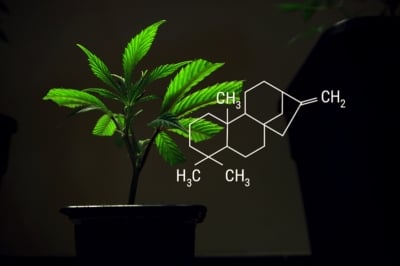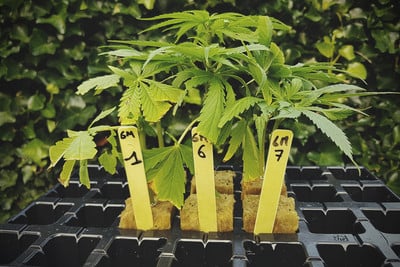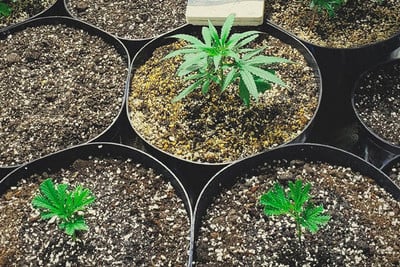.

Grafting Cannabis: How to Grow Multiple Strains on One Plant
This guide shows you how to graft cannabis like a pro. Discover the tools you’ll need, the benefits of grafting, insights from scientific studies, and a full step-by-step process to get started. Learn how to combine multiple strains on one plant and take your grow skills to the next level.
Contents:
Have you heard about a lemon tree that also produces oranges, or a tree with different varieties of apples growing on it? How amazing would it be to do the same with cannabis plants! Fortunately, it's not only possible, but relatively easy. By using a technique known as grafting, you can grow multiple cannabis strains on one plant, making harvesting even more thrilling!
This article explains how cannabis grafting works, its potential benefits, why researchers are grafting cannabis, and, finally, a step-by-step guide to grafting your own cannabis plants. Ever wanted to become a mad plant scientist? Now’s your chance!
By the end of this article, you will know how to combine (at least) two plants into one incredible specimen that expresses the most desirable traits and adds something unique to your grow space!
What Is Cannabis Grafting, and How Does It Work?
Cannabis grafting uses a technique known as splicing to fuse multiple cannabis strains. The technique can be used with two or more strains, with the desired outcome of producing various strains growing off one rootstock.
At its core, grafting cannabis requires a rootstock plant and at least one donor scion—the two are then spliced together and allowed to heal for approximately a week.
The Cannabis Grafting Technique Explained (Splicing and Healing)
The process of splicing involves cutting the stem of the chosen scion to the appropriate shape before fusing it to the rootstock. There are different methods to do so—including making a pointed base to insert into the top of the rootstock—however, the most common is to make a diagonal cut on both the rootstock and scion to make for perfect alignment.
The stems are then bound together, and require around a week or so to heal before the binding is taken off. During this time, they should be left untouched and allowed to fully recover.
Marijuana Grafting vs Traditional Cloning Methods
Traditionally, growers use cloning methods to produce a genetic replica of a mother plant. However, marijuana grafting differs from traditional cloning methods, as highlighted below:
- Cannabis grafting is complex, labour-intensive, and best suited for those well-versed in horticulture.
- Grafted cannabis plants feature two or more unique genetics, instead of just one as with clones.
- Grafting improves root health and can influence cannabinoid composition.
- There is a more significant number of tools needed for grafting marijuana.
- A grafted plant is capable of enhanced yields once healed.
Why Graft Marijuana Plants?
There are many reasons both researchers and curious home-growers are grafting cannabis, discovering the benefits associated with this 4,000-year-old technique.
While cloning is useful for producing genetic replicas, grafted plants are in a league of their own regarding performance, yield, and cannabinoid content. Below is an explanation of the potential benefits associated with them:
- Grafting can enhance the rooting capability of a strain that may have difficulty doing so with traditional cloning techniques.
- You can graft cannabis plants to preserve genetics.
- You can use grafting to create a unique hybrid without genetic modification.
- Grafting will improve the growth structure, resilience, and vigour of the scion.
- Grafted cannabis plants only require around one week to fully heal.
Growing multiple strains on one plant gives a grower much more choice when harvesting. The scion may benefit from improved disease resistance due to the robust root system of the rootstock, and yields can improve due to enhanced nutrient uptake. Ultimately, grafting is an excellent way to produce a unique and custom hybrid highlighting the properties of both the rootstock and scion.
Not only does grafting improve cannabis quality, but it can allow you to experience multiple strains without growing more plants than the legal limit allows. It’s also perfect for growers with limited space who can’t fit multiple plants even if they wanted to.
Scientific Studies on Cannabis Grafting
Multiple scientific studies have explored the effects of grafting on cannabis plants, with a specific focus on areas including cannabinoid concentration, yield production, and more.
A study[1] from 2024 shows that rootstock type influenced the survival rate, morphological parameters, and the biochemical composition of cannabis plants.
- Summary: A relative comparison between grafted and non-grafted plants shows that the grafts had improved characteristics in most cases, indicating the great potential of the grafting technique for cannabis production. With this in mind, breeders should prioritise developing rootstocks that resist biotic and abiotic factors to improve grafting success and plant resistance.
A study[2] from 2022 found significantly higher quantities of cannabinol (CBN) in one CBD1 graft type, as well as increased concentrations of THCA.
- Summary: The grafting process may have accelerated senescence, so the flowers were more mature at harvest. However, no differences in the dry weight of the flowers or visual symptoms of accelerated maturity were observed. The grafting method can alter stem morphology and, in the right combination, improve biomass and THCA yields.
Further research[3] published in 2024 shows that all cannabis grafting treatments significantly improved vegetative markers and yield.
- Summary: A high-THC variety, FSE, was grafted onto three different rootstocks—High-THC, High-CBD, and Balanced. The best overall vegetative performance—height, stem circumference, number of mature leaves—was that of plants grafted onto the Balanced and High-CBD rootstocks, which also resulted in high yields.
According to leaf mineral content analysis, the highest nitrogen and phosphorus levels were found in leaves of FSE grafted on the balanced rootstock. The cannabinoid content profile analysis revealed that all grafting treatments raised the THC level in FSE's inflorescences by 8–12% in comparison to the non-grafted control. The High-THC rootstock came in with the highest THC level.
The results from all of these studies indicate the importance of grafting in cannabis as a tool to increase the productivity and quality of the product. Now that you know why both growers and researchers are interested in cannabis grafting, let's get into how to do it yourself!
How to Graft Cannabis Plants: Step-by-Step Guide
If you're wondering whether you can graft any cannabis strain onto another, the answer is yes! As mentioned, you’ll need to select one plant as the rootstock, and one plant as the scion.
Below is a list of the equipment needed, instructions on identifying the best rootstock and scion to use, and a step-by-step tutorial for grafting.
Equipment
- Scalpel/razor blade
- Gardening shears
- Grafting or plumber's tape
- Plastic bags with a seal (extra-large ziplock bags work well)
- Gardening wire
- Glass of water
- Clean cutting board
- Spray bottle containing a nutrient solution adjusted to pH 6
- Vegetative nutrient solution
Best Rootstock and Scion for Grafting Cannabis
Your choice of rootstock for grafting should exhibit strong growth and good health, as it will be subjected to some degree of stress during the grafting process. Moreover, it should be resistant to plant diseases, pathogens, and harsh environmental factors. Finally, the plant should be well into the vegetative stage.
If you know the rootstock to use, you must pick the donor plant that will become the scion next. Grafting cannabis is an excellent way to enhance undesirable traits in a scion that may not have the best root system to begin with or lacks vigour. For example, cannabis plants that were difficult to root when performing traditional cloning methods make great candidates for grafting.
It’s very important to note that the stems of both the rootstock and scion should be compatible in width and thickness to make the fusing process straightforward.
Step-by-Step Grafting Process
Step 1: Select your rootstock and scion. Both plants should be in the vegetative stage—do not use flowering cannabis plants.
Step 2: Remove most of the scion's foliage using a sharp scalpel, leaving behind the top internodal growth and top set of leaves.
Step 3: Cut away the scion from the donor plant using a sharp and clean pair of garden shears.
Step 4: Using a chopping board, cut the base of the scion at a 45-degree angle to create more surface area. Then, place the scion into the glass of water.
Step 5: Using the scalpel, remove the leaves and side shoots from the rootstock. Cut the fusing point of the rootstock at a 45-degree angle to bind perfectly with the scion.
Step 6: Take the scion from the glass of water and quickly spray the 45-degree slice on both the scion and rootstock with the pH-balanced solution. Align the two so they fit together.
Step 7: Now that they are joined, use the tape to bind them together, starting with a small piece.
Step 8: Take a larger piece of tape and firmly wrap it around the connected scion and rootstock to bond them properly. The tape will block light and air from the cut and can be removed a few days after the graft has fused the two stems.
Step 9: Carefully wrap the gardening wire in a crisscross formation 1 cm below and above the tape to produce a tight and secure fit over the graft site.
Step 10: Take the plastic bag and lightly spray the inside with your solution to create a high-humidity environment. Place the bag over the top of the scion and tie it, but do not let the leaves touch the bag.
Once a week has elapsed, remove the plastic bag, wire, and tape, and just like that—you have a grafted plant.
Does Grafting Improve Cannabis Quality and Yield?
According to the scientific studies referenced above, yields from grafted cannabis plants were significantly higher than those from non-grafted plants. There was also a noticeable difference in cannabinoid concentration, which in turn influences overall potency.
So it is fair to say that, in these examples, grafted cannabis plants were superior to non-grafted ones and produced enhanced yields and THC/CBD ratios.
Challenges and Risks of Grafting Weed Plants
Grafting can be an involved task best suited for experienced growers; however, done correctly, it produces strong, robust plants. A grower experimenting with cannabis grafting may encounter mistakes such as:
- Not allowing the plants enough time to heal before removing the tape and wire.
- Providing incorrect humidity levels during the propagation phase.
- Using a scion and rootstock that are incompatible in size and width.
- Attempting grafting with softwood cannabis plants.
- Using blunt garden shears and failing to make a clean and precise cut.
- Selecting a rootstock that is highly susceptible to pathogens and disease.
Final Thoughts: Is Cannabis Grafting Worth It?
Looking deeper into the anecdotal benefits and scientific studies associated with cannabis grafting, it appears it is well worth the time and effort! Grafting enhances rooting capabilities, preserves genetics, saves space, and improves donor scion growth structure, resilience, and vigour.
Cannabis grafting may not currently be as popular as traditional cloning methods. However, who's to say it won't become the next big thing in commercial cannabis once more growers learn about its benefits? Challenge yourself with your first cannabis graft, and there is a good chance you will never go back to regular cloning. Good luck experimenting with your favourite strains and taking your horticultural skills to another level!








































